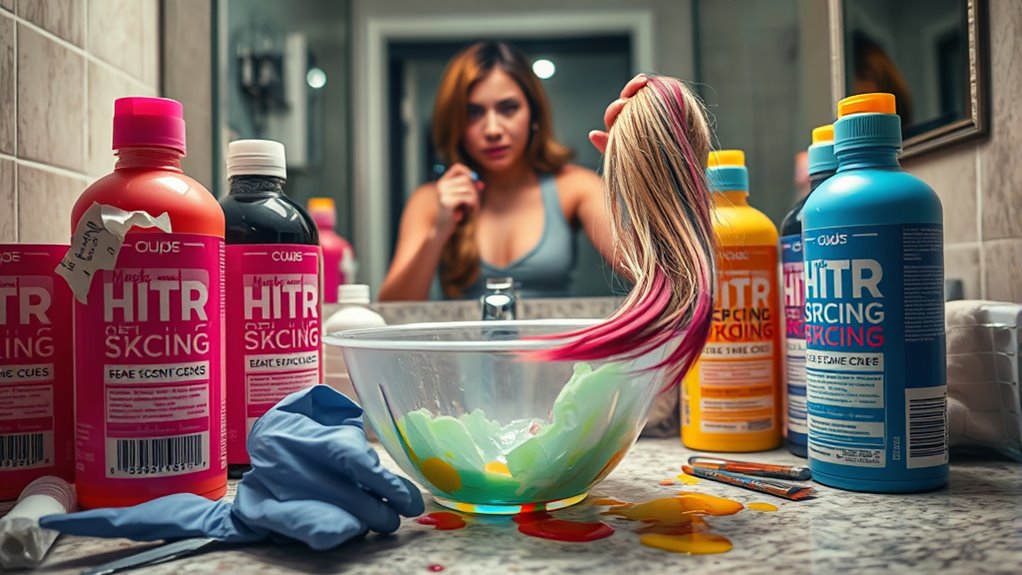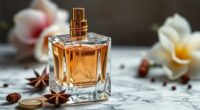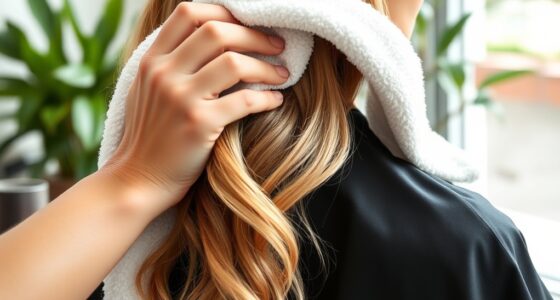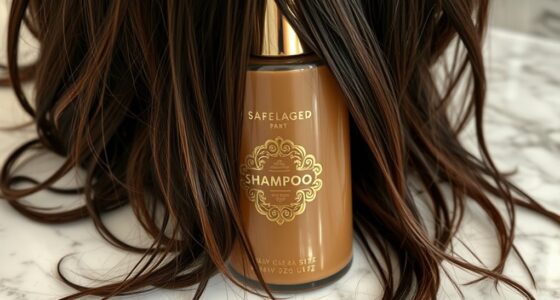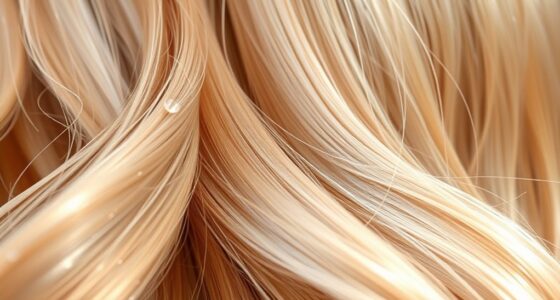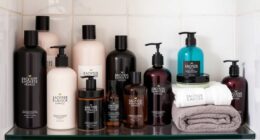Professional colorists avoid at-home hair dye brands because these products often contain unregulated chemicals like PPDs and metallic salts that can cause long-term damage, allergic reactions, and health risks. They lack customization, which leads to unpredictable results and can weaken your hair over time. Plus, these dyes don’t offer the control or advanced formulations used by professionals. If you want to understand how safer, tailored solutions can protect your hair’s health, keep exploring.
Key Takeaways
- At-home dyes often contain unregulated, harmful chemicals like PPDs and metallic salts that can damage hair and pose health risks.
- They lack customization options, leading to unpredictable results and difficulty neutralizing unwanted tones or matching specific shades.
- Low-quality ingredients weaken hair over time, causing brittleness, breakage, and long-term damage that professionals avoid.
- DIY dyes increase the risk of mistakes, uneven color, and costly corrections, which professionals are trained to prevent.
- Professional colorists prefer formulations with nourishing agents and bonding technologies for safer, longer-lasting, and healthier results.
The Risks of Using Unregulated Chemicals in At-Home Dyes
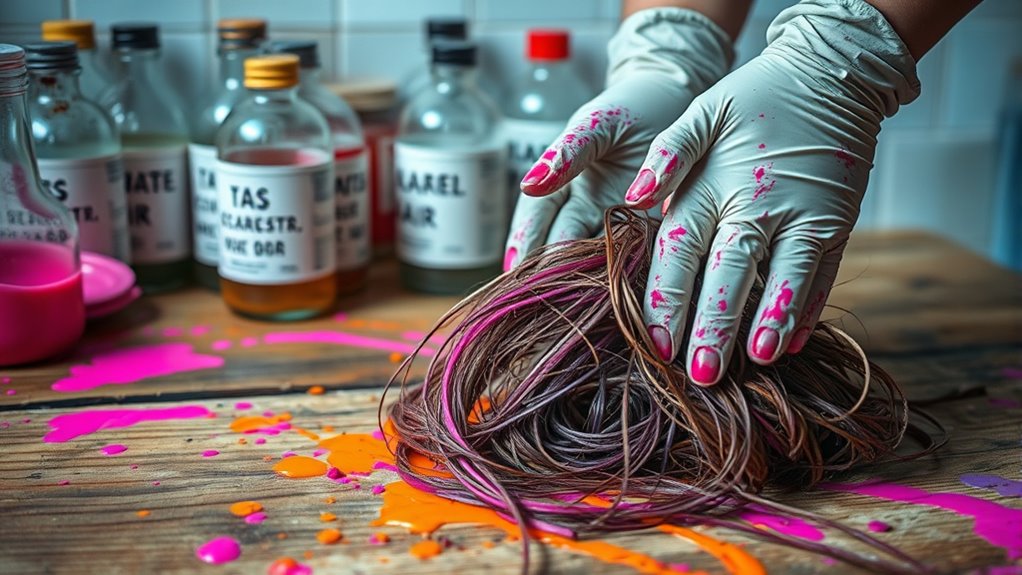
Using unregulated chemicals in at-home hair dyes can pose serious health risks. These unregulated chemicals, like PPDs, nitro dyes, and metallic salts, can trigger allergic reactions and skin sensitivities. You might experience redness, itching, or swelling after application, but the dangers go beyond immediate discomfort. Repeated exposure to these substances increases long-term health risks, including potential links to bladder cancer and other health issues. Many inexpensive box dyes contain low-quality ingredients and hidden toxins, making their chemical makeup unpredictable. Since these products lack proper oversight and regulation, harmful substances are often undisclosed, raising the chance of adverse effects. Uncontrolled chemical reactions during DIY dyeing can also cause hair damage, breakage, and uneven results, compounding the health and aesthetic risks you face. Additionally, the lack of regulation means that safety standards are often not met, further increasing the potential for harmful outcomes. Moreover, the absence of regulatory oversight means that consumers cannot be assured of the chemical safety of these products, heightening the risks involved. It is essential to be aware that some unregulated dyes may also contain heavy metals, which are linked to serious health problems. Furthermore, without proper regulation, the presence of contaminants and untested formulations can exacerbate these dangers. Being aware of the regulation process can help consumers make safer choices and avoid these hazards.
Lack of Customization and Personalization
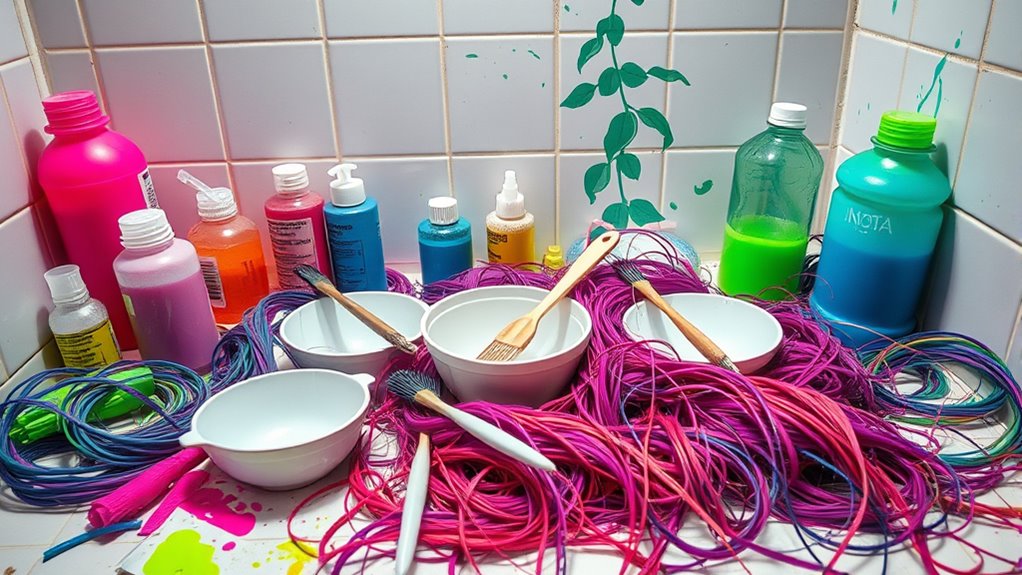
At-home hair dyes are designed for quick and easy use, but their one-size-fits-all formulas fall short when it comes to matching individual hair needs. Customization is essential for achieving the perfect shade and ensuring hair health, but these products lack the flexibility to adapt. The formulation of DIY dyes doesn’t account for your hair’s unique porosity, existing pigment, or prior chemical treatments, which can lead to uneven or unpredictable results. Professional colorists tailor formulas based on these factors, adjusting developer strength and adding nourishing agents to protect your hair. At-home brands simply can’t provide this personalized approach, leaving you with limited shade options and less control over the final outcome. This lack of personalization makes them unsuitable for those seeking precise, safe, and customized color results.
Poor Ingredient Quality and Potential Hair Damage
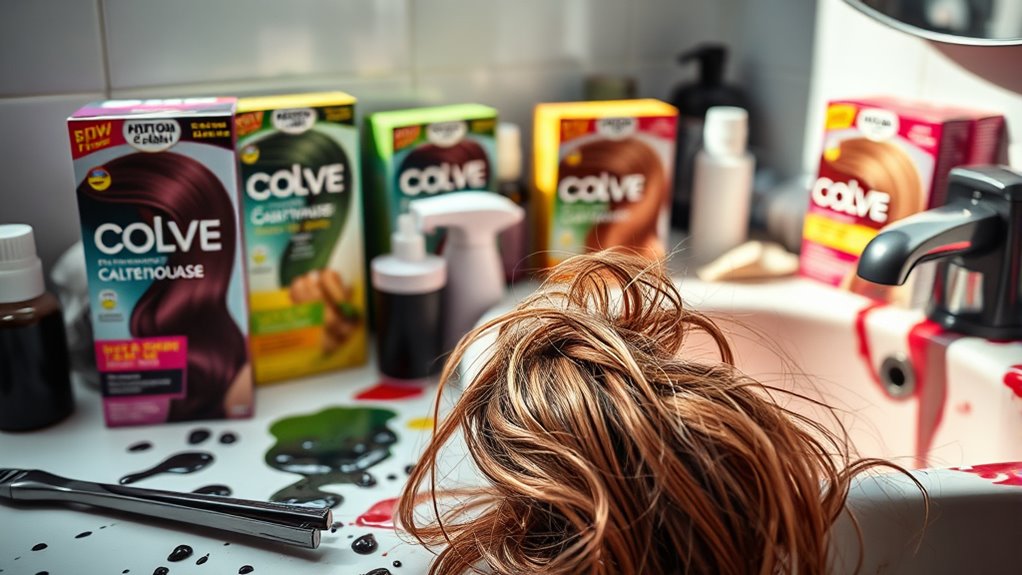
At-home hair dyes often contain low-quality chemicals like harsh dyes and additives that can weaken your hair over time. These ingredients, such as ammonia and PPDs, can cause brittleness, breakage, and dullness, especially with repeated use. Since ingredient standards vary widely, you risk irreversible damage that requires costly treatments or cuts to repair. Additionally, many of these products lack transparency about their product labeling and safety testing, increasing the risk of adverse effects. Furthermore, the absence of regulatory oversight means that some formulations may contain undisclosed harmful substances, which can lead to further damage and health risks, and the lack of quality control can result in inconsistent formulations that exacerbate hair damage.
Low-Quality Chemical Components
Low-quality hair dyes often contain cheap, unrefined chemicals like PPDs, ammonia, and metallic salts that can seriously damage your hair cortex and weaken strands over time. These poor ingredient quality components are harsh and lack the nourishing agents found in professional products. PPDs, in particular, can cause allergic reactions and scalp irritation, while metallic salts may lead to unpredictable color results and buildup. Ammonia, used to open the hair cuticle, is highly damaging when not properly balanced or regulated. The use of these low-grade chemicals increases the risk of dryness, breakage, and long-term damage, making your hair more fragile and less healthy. Without high-quality ingredients, these dyes compromise your hair’s strength and overall condition with each use. Regular use of such dyes can also lead to cumulative damage that is difficult to reverse, especially since they often lack skin-nourishing ingredients that protect and strengthen hair during coloring. Additionally, many of these formulations do not contain beneficial hair conditioning agents, which are essential for maintaining moisture and elasticity.
Damage From Harsh Additives
Harsh additives in inexpensive hair dyes can cause significant damage to your hair over time. These chemicals, like ammonia and PPDs, weaken the hair shaft and increase breakage. Using a box dye loaded with harsh additives accelerates damage from harsh additives, leaving your hair dry, brittle, and prone to splitting. Asset division laws can influence how much of your hair care routine’s damage may be considered during legal proceedings. Consider these points:
- Harsh additives strip natural oils, causing dryness and straw-like texture.
- Lack of conditioning agents in cheap dyes makes hair more susceptible to frizz and breakage.
- Metallic salts and unregulated chemicals can trigger unpredictable reactions, worsening damage.
- The presence of unregulated chemicals underscores the importance of understanding AI safety measures to minimize health risks associated with harmful substances.
Repeated use of poor-quality dyes compounds this damage, leading to long-term harm that’s often costly to repair. Avoid these risks by steering clear of box dyes with harsh additives.
Inconsistent Ingredient Standards
Because ingredient standards vary widely among at-home hair dye brands, you can’t always predict how your hair will react. Inconsistent ingredient standards can lead to unpredictable color results and increase the risk of allergic reactions. Many budget dyes contain metallic salts and chemical fillers that can cause buildup over time, making future color corrections more difficult. These lower-quality ingredients often lack the nourishing agents found in professional products, which means repeated use can weaken your hair and cause damage. Without regulated, high-grade ingredients, you’re more likely to experience dryness, breakage, and uneven coloring. Additionally, regulatory oversight of these products is often limited, further increasing the risk of harmful ingredients slipping through. Professional colorists choose products with consistent, safe ingredients to protect hair health, but at-home brands frequently cut corners, increasing the chance of damage and unpredictable outcomes. Moreover, using products with inconsistent ingredient quality can compromise the long-term health of your hair, leading to cumulative damage over time. Furthermore, these products often lack the nutrient-rich formulations necessary to support hair integrity during chemical processes.
Inconsistent and Unpredictable Results
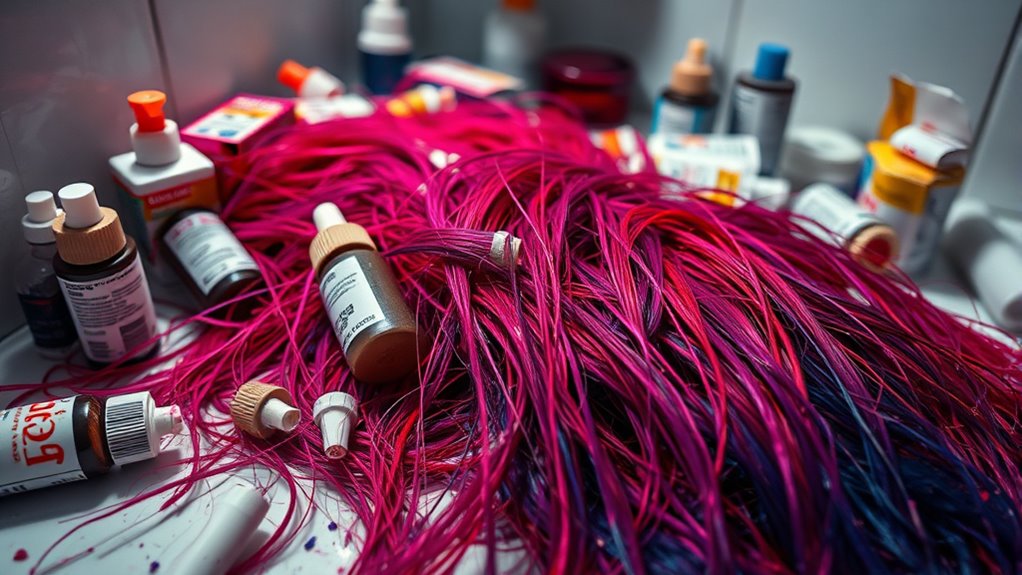
At-home hair dyes give you limited control over the final color, often leading to unexpected results. Because the formulas are fixed and can’t be customized, your hair might turn out different than what you envisioned. Variations in hair type and application technique can make the results even more unpredictable. Additionally, some brands lack the professional quality found in salon products, increasing the likelihood of undesirable outcomes. Without proper formulation, you risk uneven color, damage, or allergic reactions that could be avoided with vetted professional products. Relying on untested brands may also mean missing out on the safety standards upheld by professionals, which are designed to protect your hair and health. Proper product maintenance and the use of high-quality formulations are essential for achieving consistent, predictable results.
Lack of Formulation Control
Since at-home hair dyes use a single, fixed developer strength, they limit your ability to adapt the chemical process to your hair’s unique needs. This lack of formulation control means you can’t adjust pigment levels or developer strength based on your hair’s porosity, color history, or damage. As a result, box dyes often produce inconsistent results. To clarify:
- They lack customization options, preventing you from tailoring the formula to your hair’s specific condition.
- Fixed developer strengths can lead to over- or under-processing, causing uneven color.
- Inability to modify formulations increases the risk of unwanted tones or patchy coverage.
Professional colorists avoid these products because they can’t manipulate formula components to ensure predictable, uniform results across different hair types.
Unpredictable Color Outcomes
Unpredictable color outcomes are a common issue with box dye, as they lack the precision needed to account for your hair’s unique characteristics. Because box dyes don’t customize for hair porosity or underlying pigments, the results can vary widely. Limited shade options prevent proper neutralization of unwanted tones, leading to unpredictable color or even greenish and muddy hues. Additionally, box dyes don’t consider your hair’s previous treatments or color history, which can cause unexpected shifts. The fixed developer strength isn’t adaptable to different hair conditions, resulting in uneven lift and deposit. Without professional expertise, DIY application often leads to patchy, flat, or uneven hair tone. For consistent, predictable results, professional hair color is designed to match your specific hair needs precisely.
Limited Shade Options and Inability to Neutralize Tones
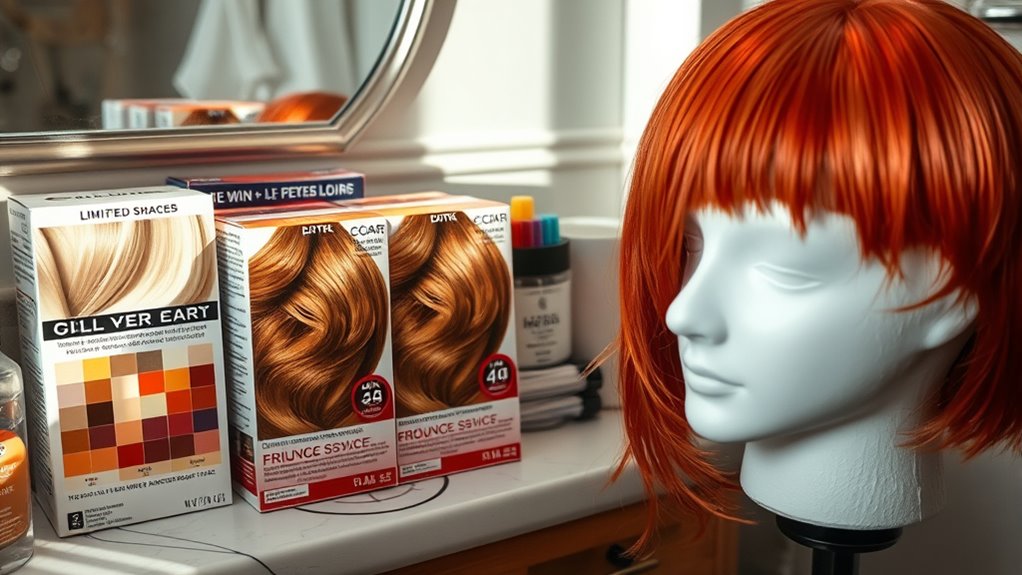
Limited shade options in box dyes often mean you can’t find the exact hue you want, such as a natural brunette or a subtle ash tone. This restricts your ability to customize shades to match your desired look. Additionally, these brands lack the ability to neutralize tones, making it difficult to counteract unwanted pigments like orange, yellow, or green. Without the right tools, you can’t adjust formulations to achieve a balanced, natural result. Here are some key issues:
- Limited shade options reduce the chances of matching your ideal color.
- Inability to neutralize tones leads to off-putting or uneven results.
- Lack of customization options results in unpredictable outcomes, especially on dark or previously colored hair.
These limitations explain why professional colorists avoid relying on at-home dye brands.
The Hidden Costs of Fixing Mistakes
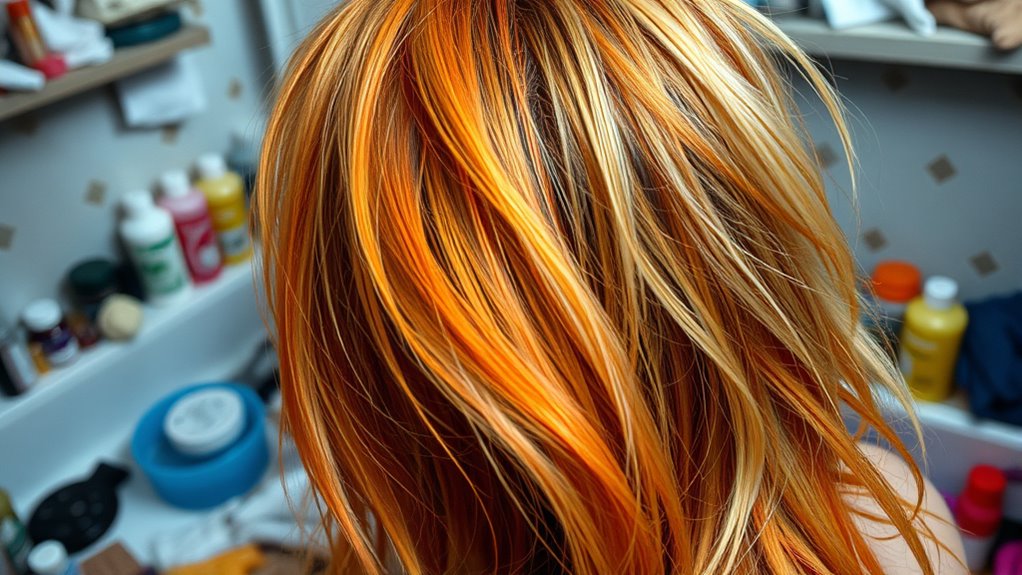
Fixing hair dye mistakes at home can quickly become expensive, often costing three times more than the original dye job. Each correction step adds to damage and may require multiple salon visits to fix. In the end, trying to repair a mistake yourself might leave you with damaged hair and higher costs than expected.
Expensive Correction Sessions
When you realize a DIY hair color mistake, the cost to correct it can quickly spiral out of control, often costing three times more than a professional service—sometimes between $300 and $500 per session. These expensive correction sessions involve multiple steps like stripping, toning, and deep conditioning, which add up fast.
- Fixing green or orange tones with corrective color treatments can be costly and time-consuming.
- Relying on box color instead of salon hair color often results in more complex corrections, driving up expenses.
- Multiple appointments for damage control and color adjustments can surpass the initial cost of professional coloring.
Trying to fix mistakes yourself not only risks further damage but also increases your overall repair costs profoundly.
Hair Damage Accumulation
Attempting to correct DIY hair color mistakes often leads to unseen damage that accumulates over time. Repeated use of box dye causes hair damage that builds up, resulting in brittle, straw-like strands that are hard to repair. Fixing these mishaps usually requires multiple professional salon treatments, including stripping color and deep conditioning, which further weaken your hair’s integrity. Many store-bought dyes contain low-quality ingredients that leave chemical residues and metallic salts, making future coloring even more unpredictable and damaging. Each incorrect application or overprocessing causes microscopic breakage and thinning, increasing the risk of permanent damage. The cost of repairing this accumulated damage from amateur coloring can surpass the price of professional services, requiring extensive restoration to bring your hair back to health.
How Box Dyes Compromise Hair Health Over Time
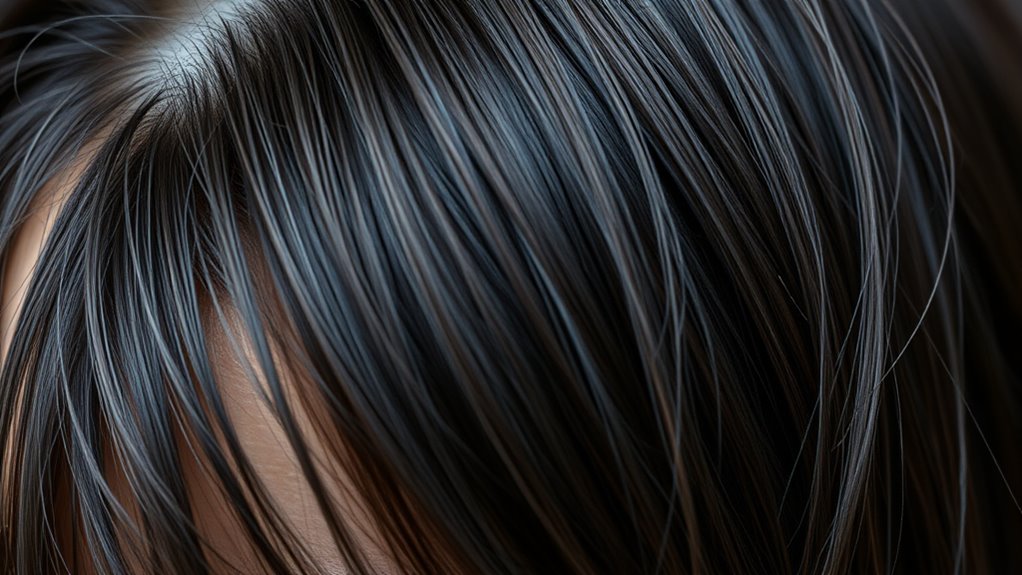
Repeatedly using box dyes can considerably weaken your hair over time because these products often contain damaging chemicals like ammonia and metallic salts. These substances harm the hair cuticle and cortex, leading to increased porosity and fragile strands. Over repeated applications, the low-quality ingredients cause cumulative damage, resulting in a straw-like texture and breakage.
Repeated use of box dyes weakens hair by damaging the cuticle and cortex, causing fragility and breakage over time.
Here are three ways box dyes harm your hair long-term:
- Metallic salts build up, dulling your hair and making it resistant to professional color corrections.
- The damaging chemicals weaken strands, reducing elasticity and increasing the risk of split ends.
- Increased porosity makes your hair more susceptible to future damage and uneven color absorption, further compromising hair health.
Professional Colorists’ Concerns About Safety and Health Risks
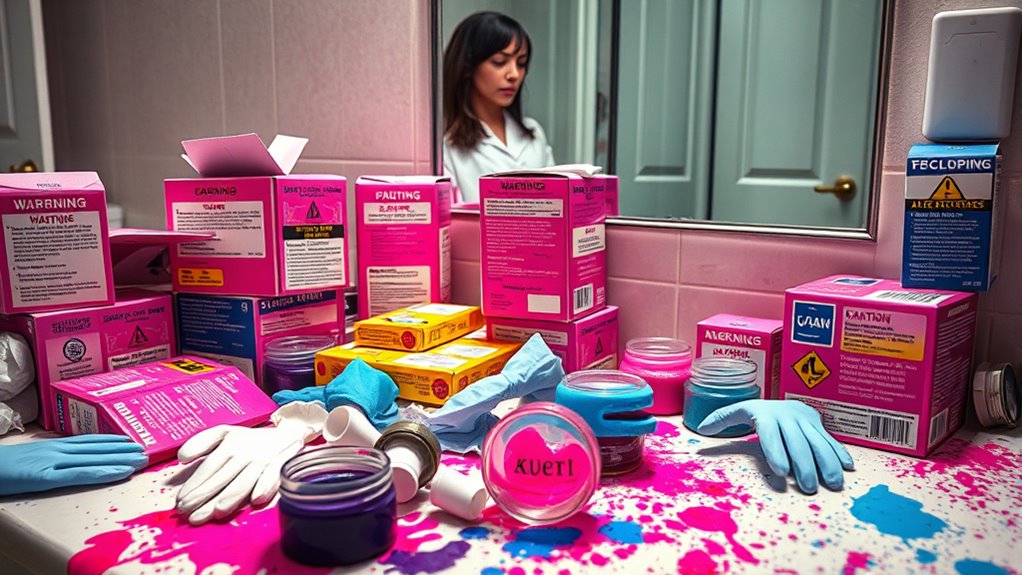
Professional colorists are deeply concerned about the safety and health risks associated with many at-home hair dye brands. The ingredients in these dyes often include unlisted or harmful chemicals, like aromatic amines linked to cancer, which pose serious health risks. The chemical composition of box dyes can contain metallic salts and low-quality ingredients that cause unpredictable reactions and damage hair or scalp health. Without standardized safety testing or ingredient transparency, it’s difficult to assess the true risk, increasing the potential for allergic reactions and long-term health issues. As professionals, we prioritize formulations with safer chemicals and nourishing agents to protect both your hair and overall health. Using products with unknown or unsafe ingredients can expose you to unnecessary hazards and health concerns.
The Benefits of Professional Formulations and Techniques
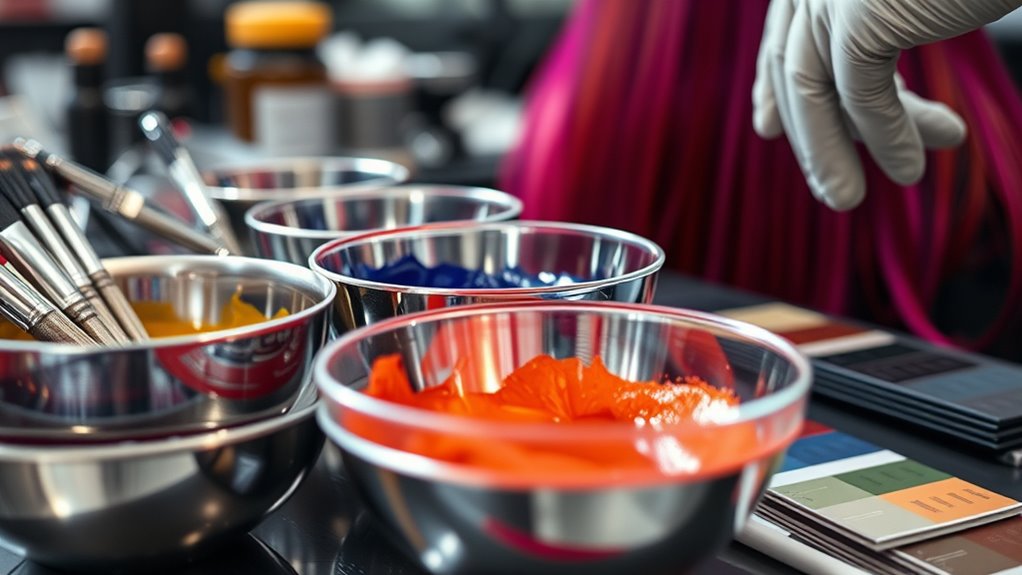
Choosing professional formulations and techniques guarantees your hair receives the highest quality care and results. With professional formulations, you benefit from nourishing ingredients like milk proteins and amino acids that strengthen hair during coloring. These products are customizable, allowing your colorist to tailor formulas based on your hair type, porosity, and desired shade, ensuring ideal results. Advanced developer strengths and bonding technologies enable precise pigment deposition and neutralize unwanted tones, reducing damage and fade.
Here’s what makes professional techniques superior:
- Precise application methods, like sectioning, create even, natural-looking color.
- Customizable formulations minimize damage and enhance vibrancy.
- Skilled techniques ensure long-lasting, healthy results.
This approach safeguards your hair’s health while delivering stunning, professional color.
Why DIY Hair Color Often Leads to Longer-Term Damage
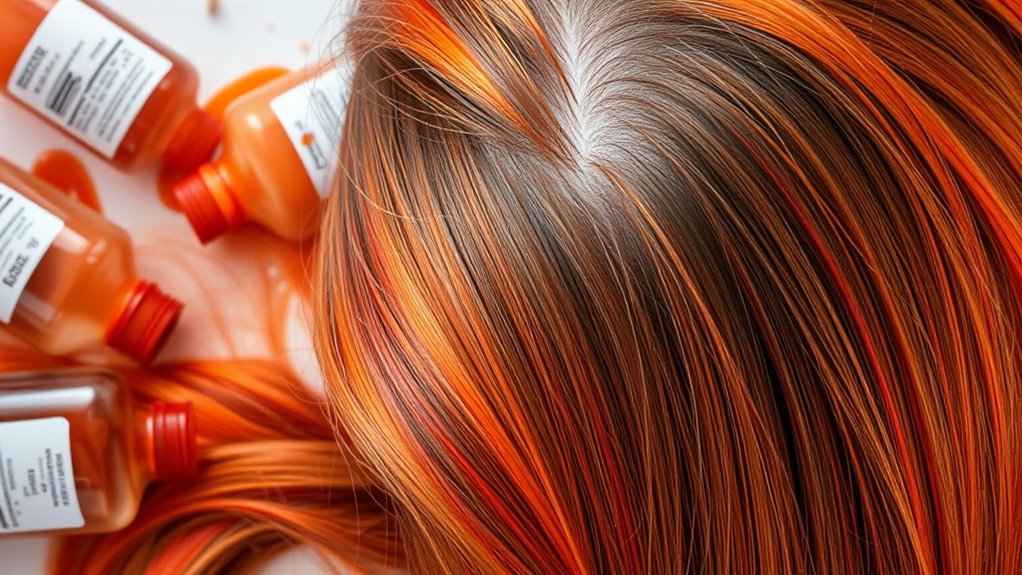
DIY hair coloring often leads to long-term damage because many at-home dyes contain harsh chemicals like ammonia and PPDs that weaken the hair cortex, causing increased brittleness and breakage over time. When you use inferior hair dye products, the damage accumulates, making your hair straw-like and difficult to repair. Incorrect application and lack of professional formulation control can result in uneven pigment buildup, which heightens the risk of long-term damage and discoloration. Repeated at-home coloring without proper toning or conditioning accelerates color fading and weakens your hair’s structural integrity. Improper bleaching or coloring techniques at home can cause irreversible damage, such as split ends and loss of elasticity, often requiring costly salon repairs. Trusting a professional helps prevent these long-term damage issues and maintains healthier hair.
Frequently Asked Questions
Why Do Hairdressers Say Not to Use Box Dye?
You might wonder why hairdressers advise against box dye. They know it uses lower-quality ingredients and harsh chemicals that can damage your hair and scalp. Plus, it’s one-size-fits-all, so it can’t be customized for your hair’s unique needs. This often results in uneven color, fading, and breakage. Applying box dye over previous color can cause unpredictable results and make future corrections much more difficult.
What Brand of Hair Dye Do Hairdressers Use?
They say “you get what you pay for,” and that’s true for hair dye too. As a professional, you’ll use brands like Wella Koleston, Goldwell, L’Oréal Professionnel, and Schwarzkopf Igora. These brands offer extensive shades, customization, and nourishing ingredients, ensuring vibrant, long-lasting results. You choose these because they give you control, quality, and safety, unlike lower-quality, limited at-home options that can damage hair and lead to uneven color.
What Hair Dye Brands Should I Avoid?
You should avoid at-home dye brands like Sally’s, Clairol, and L’Oréal boxed dyes. These often contain harsh chemicals, metallic salts, PPDs, and ammonia that can damage your hair and cause allergic reactions. They lack customization, making it hard to get natural shades or fix mistakes. Plus, their ingredients build up over time, leading to uneven color, fading, and long-term damage. Stick to professional brands for better results and healthier hair.
Is It Better to Dye Your Hair Professionally or at Home?
Did you know that at-home dye kits often cause damage in 60% of users? When you choose to dye your hair professionally, you get expert guidance, customized formulas, and high-quality products that safeguard your hair’s health. DIY dyes can lead to uneven color and costly fixes, while professionals ensure safe, beautiful results. So, for the best look and hair health, it’s smarter to trust a pro.
Conclusion
Choosing professional hair coloring is like planting a sturdy tree rather than a fragile sapling—you invest in health and lasting beauty. DIY dyes may seem convenient, but they often cause more harm than good, leaving your hair vulnerable like a delicate glass sculpture. To keep your hair strong and vibrant, it’s smarter to trust the pros who understand the science and artistry behind safe, customized color. Your hair deserves the best—don’t settle for less.
